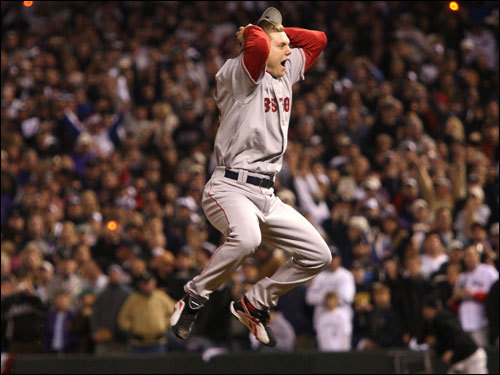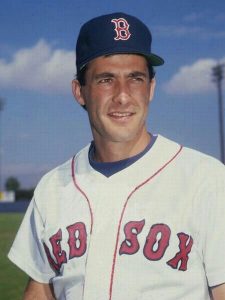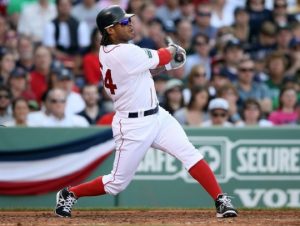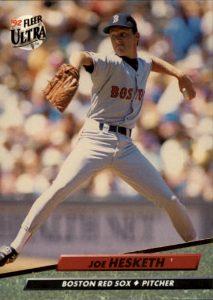The uniform numbers 56-60 for the Boston Red Sox feature the franchise’s greatest closer, and one of the more dominant postseason closers ever. It also celebrates a man who had a t-shirt made about him this past season. Find out who makes the cut for the numbers 56-60.
Number 56 – Joe Kelly
Joe Kelly gathered quite a following for himself this past season. On April 11, Joe Kelly hit Yankees Tyler Austin with a pitch and urged him to charge the mound. Kelly proceeded to win the fight and the hearts of many Bostonians. Shirts were made about it, titled “Joe Kelly Fight Club.”
Kelly was miscast as a starting pitcher when he first came to Boston, but he mostly did well after being moved to the bullpen. Throwing heat reaching 100 at times, Kelly’s two-pitch mix featuring the heater played up much better in the pen. After a mediocre run from the trade deadline in 2014 through 2015, Kelly had a miserable six start stint in the first half of 2016. Moved to the bullpen, he went 2-0 with a 1.02 ERA over 14 appearances the rest of the season.
Kelly was excellent in 2017, winning four games against just one loss. He had a 2.79 ERA and at one point pitched 23 straight games without allowing a run.
This past season had its ups and downs, but Kelly came through when it mattered most. He allowed only one run over a span of 24 games early in the season before hitting tough times. He finished the season with a 4.39 ERA, but with an ERA over 8.00 in June, July and September. Come playoff time, fighting Joe Kelly was back. He allowed just one earned run over 11.1 innings and pitched six shutout innings in the World Series. This gave him a 0.51 ERA in the postseason over three postseason trips with the Red Sox.
Honorable Mentions: Darren Bragg, Ramon Ramirez

Number 57 – Eduardo Rodriguez
Another member of the 2018 World Series Champions, Rodriguez will likely be back with the club in 2019, unlike Kelly. This past season was the first of Rodriguez’ career where he wore the number 57, but he still did enough to earn the nod. Over his first three seasons he wore number 52 and earned an honorable mention at the number.
2018 is all that gets factored in for the sake of this article, because it is only what he did while wearing this particular number. Rodriguez won 13 games for the Red Sox and only lost five. He had a nice 3.82 ERA and struck out 10.1 batters per nine innings pitched. On September 1st he struck out 12 White Sox in only 5.2 innings pitched in his return from a disabled list stint. Rodriguez didn’t pitch very well in the postseason, but he certainly helped the team in setting a franchise record for wins.
Honorable Mention: Ron Mahay

Number 58 – Jonathan Papelbon
Papelbon was always so intimidating on the mound; the way he lowered his head to peer in at the signs, his eyes just looking out from under the brim of his cap with a look that said “I’m going to throw this ball through you.” He could back it up too. Over his first four seasons, Papelbon was probably the best closer in all of baseball.
After showing potential as a call-up in 2005, Papelbon served as the Red Sox closer in 2006 and never looked back. He posted one of the most dominant seasons you will find, pitching to a 0.92 ERA and 0.78 WHIP. Papelbon saved 35 games that season as a rookie.
In 2007 he struck out a career best 13 batters per nine innings. He had a 1.85 ERA, 0.77 WHIP and saved 37 games. In the postseason he was untouchable, pitching 10.2 shutout innings. Papelbon saved three games in the World Series and was on the mound for the final out.
Papelbon continued his dominant ways, saving 41 games the next year before lowering his ERA back under 2.00 in 2009. From 2006-09 he had a 1.74 ERA, 0.92 WHIP, 10.6 K/9 and 151 saves. He wasn’t as dominant his last two years in Boston, but he did have a WHIP under 1.00 again in 2011.
Papelbon made four all-star teams with the Red Sox, and saved a franchise record 219 games. During the postseason he pitched 26 shutout innings before he was finally scored upon. He is the greatest Red Sox reliever for an entire body of work, and the only 58 worth mentioning.
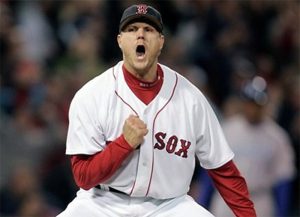
Number 59 – Tommy Layne
Layne is not a name one might expect to find here, but crazy things happen in the higher numbers. He was a lefty specialist for the Red Sox over parts of three seasons, making the trip to and from Pawtucket a few times.
Layne first appeared on the team in 2014, posting a sterling 0.95 ERA over 30 relief appearances, totaling 19 innings. This would not be the norm, but that isn’t the norm for anyone. He did a solid job with the team over the next two seasons before they moved on. He put men on base, but at least never had an ERA of 4.00 or higher until he pitched for the Yankees in 2017. Over 95.1 innings in Boston, Layne had a 3.30 ERA.
Honorable Mention: Clayton Mortensen

Number 60 – Daniel Bard
But wait, Daniel Bard was number 51 you say? That’s correct, Bard did most of his work wearing the number 51 on his back and was chosen as the greatest Red Sox player to wear that number. So how come he is number 60 as well? His rookie season, Bard wore the number 60, and the competition is very light. Daniel Nava wore the number 60 for only one season as well, his rookie season, and Bard had a better rookie season than Nava did.
Bard pitched 49.1 innings that year, showing off his 100 mile per hour heater. He had a 3.65 ERA and struck out 63 batters at a career best 11.5 batters per nine innings. He was dominant in front of his home crowd, going 2-0 with a 1.46 ERA at Fenway Park. In the postseason that year he pitched three perfect innings, striking out four batters.
Honorable Mention: Daniel Nava (2010)

Featured picture from Boston.com
